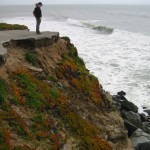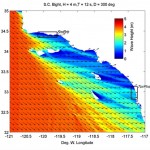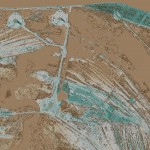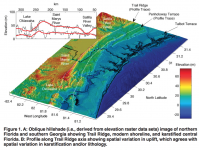In the most general sense, our group’s research focuses on understanding relationships between geomorphic landforms and the processes that create/shape them. In many cases, this requires an understanding of constructional processes (tectonics, isostasy, etc.) as well as sculpting processes (fluvial incision, wave orbital sediment entrainment, etc.) and the frequency-magnitude relationships of surface processes – that’s where climate comes into play. We have organized our projects into several ongoing themes, each of which is summarized below.
 | Rocky Coast MechanicsThis work stems from Pete Adams's doctoral dissertation "Assessing Coastal Wave Energy and the Geomorphic Evolution of Rocky Coasts", completed under the mentorship of Bob Anderson (then-) at UC-Santa Cruz (Adams, 2004). The dissertation explored mechanisms of sea cliff retreat via flexing, fatigue, and direct impacts of nearshore waves, which were presented in two publications (Adams et al., 2002; Adams et al., 2005). Field-based research into this topic has continued through collaborations with Adam Young at Scripps Institution of Oceanography (Young et al., 2011; Young et al., 2012) that addressed the role of infragravity motions and their landward decay in geomorphic evolution and retreat of sea cliffs. Our group has also conducted numerical modeling to investigate these topics. Patrick Limber, now at the USGS-Pacific Science Center, worked with our group at UF as an NSF-funded post-doc from 2012-2014, investigating the origins and limits of millennial-scale headland/bay relief on rocky coasts (Limber et al., 2014). Recent PhD graduate, Shaun Kline produced a numerical model to study the role of sedimentary "tools" in the episodic-nature of sea cliff retreat, revealing that the slope of the inner-shore platform exerts a first-order control on rate of retreat (Kline et al., 2014). Some of this work has been highlighted in a summary chapter published by the Geological Society of London (Hapke et al., 2014). |
 | Wave Climate and Coastal EvolutionInterest in this topic developed from Adams's post-doc training at Scripps Institution of Oceanography with Doug Inman from 2005-2007. During that time, Adams and Inman investigated the wave climate within the Southern California Bight to determine that El Nino storm waves have a strong dependence upon the phase of the Pacific Decadal Oscillation (PDO), whereas La Nina storm waves do not (Adams et al., 2008). This led to a study of the influence of wave climate on erosional hotspots along the southern California coast (Adams et al., 2011; Pendleton et al., 2011). More recently, our group has collaborated on an NSF-funded project, with researchers at UNC-Chapel Hill, UNC-Wilmington, and Duke, to explore the coastal geomorphic effects of wave climate change. We are furthering our understanding of the causes and consequences of enigmatic patterns of erosion and accretion along the North American Atlantic coast (Johnson et al., 2014). |
 | Decadal, Seasonal, and Event-Scale Coastal Sedimentary ProcessesThis "catch-all" theme includes several projects at various locations including Kachemak Bay-Alaska (Adams et al., 2007), Matanzas Inlet-Florida (Adams et al., 2016), Cape Canaveral-Florida, and Fire Island-New York (Wilson et al., 2015). The fundamental link among these projects is that shoreline change (and more generally, coastal morphology) is strongly influenced by the nearshore processes that entrain and transport sediment - we aim to reveal the mechanisms by which this is occuring through a combination of field instrumentation and digital elevation measurement. Significant efforts on this research theme began in 2009 when the Environmental Lead at NASA's Kennedy Space Center (KSC) assembled the Dune Vulnerability Team (DVT) to address the causes and consequences of chronic erosion near Launch Complex 39 (launch site of the Space Shuttle, Saturn V, and Apollo missions). The team consisted of researchers from UF (John Jaeger, Pete Adams, and then-graduate student, Richard MacKenzie) as well as scientists from the U.S. Geological Survey at St. Pete, and various independent environmental consultants. Since the assembly of the DVT, we have monitored morphologic change, monthly, along the10-km reach of the KSC coast, on the north sided of Cape Canaveral, with RTK-GPS, resulting in approximately 80 beach surveys. In addition, we have collected data on nearshore currents and waves with Acoustic Doppler Current Profilers (ADCPs), and have made observations of nearshore bar variability with automated imagery. This work has been funded by NASA, the USGS, and the Bureau of Ocean Engineering Management (BOEM). |
 | Orphan Topics: Marshes, "Karstostasy", and the Geomorphic History of FloridaJust because some topics emerge that don't fit neatly into the themes above, doesn't mean we won't have a look at them. Since the completion of PhD student Jessica Lovering's dissertation, our group has been paying attention to the coupled physical-biological systems in coastal marshes. In a paper that looked at marsh platform retreat in Louisiana resulting from the BP-Deepwater Horizon spill (Silliman et al., 2012), we contributed some numerical modeling results to show that the rapid marsh shoreline retreat was not likely due to a predisposition for erosion in that location, and that oil-driven plant mortality likely destabilized the marsh platform edges, causing them to erode. Also of interest to our group is the local geomorphology of Florida. Shortly after coming to UF, Pete Adams learned about a process proposed by Neil Opdyke, in which karst-driven erosion effectively thinned the upper crust resulting in an isostatic response and uplift of central Florida. By combining published results of paleontologic assemblages, digital elevation analysis, and numerical modeling, we published a paper (Adams et al., 2010) that estimated a plausible uplift rate (0.05 mm/yr) for the Florida platform as well as age estimates for several coastal terraces along the Atlantic margin. |